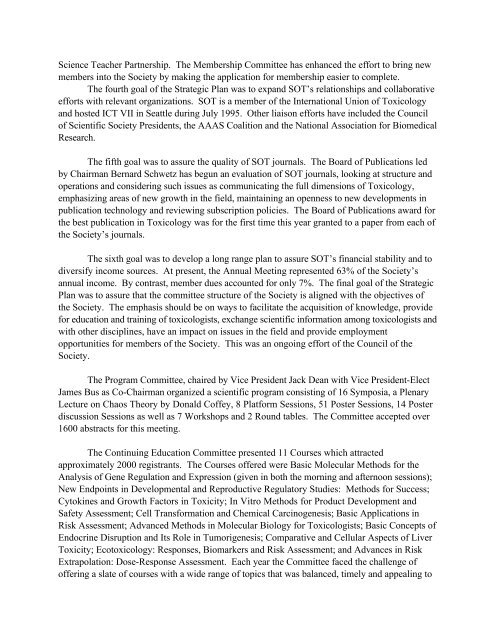SOCIETY O. TOXICOLOGY HISTORY - Society of Toxicology
SOCIETY O. TOXICOLOGY HISTORY - Society of Toxicology
SOCIETY O. TOXICOLOGY HISTORY - Society of Toxicology
You also want an ePaper? Increase the reach of your titles
YUMPU automatically turns print PDFs into web optimized ePapers that Google loves.
Science Teacher Partnership. The Membership Committee has enhanced the effort to bring new<br />
members into the <strong>Society</strong> by making the application for membership easier to complete.<br />
The fourth goal <strong>of</strong> the Strategic Plan was to expand SOT’s relationships and collaborative<br />
efforts with relevant organizations. SOT is a member <strong>of</strong> the International Union <strong>of</strong> <strong>Toxicology</strong><br />
and hosted ICT VII in Seattle during July 1995. Other liaison efforts have included the Council<br />
<strong>of</strong> Scientific <strong>Society</strong> Presidents, the AAAS Coalition and the National Association for Biomedical<br />
Research.<br />
The fifth goal was to assure the quality <strong>of</strong> SOT journals. The Board <strong>of</strong> Publications led<br />
by Chairman Bernard Schwetz has begun an evaluation <strong>of</strong> SOT journals, looking at structure and<br />
operations and considering such issues as communicating the full dimensions <strong>of</strong> <strong>Toxicology</strong>,<br />
emphasizing areas <strong>of</strong> new growth in the field, maintaining an openness to new developments in<br />
publication technology and reviewing subscription policies. The Board <strong>of</strong> Publications award for<br />
the best publication in <strong>Toxicology</strong> was for the first time this year granted to a paper from each <strong>of</strong><br />
the <strong>Society</strong>’s journals.<br />
The sixth goal was to develop a long range plan to assure SOT’s financial stability and to<br />
diversify income sources. At present, the Annual Meeting represented 63% <strong>of</strong> the <strong>Society</strong>’s<br />
annual income. By contrast, member dues accounted for only 7%. The final goal <strong>of</strong> the Strategic<br />
Plan was to assure that the committee structure <strong>of</strong> the <strong>Society</strong> is aligned with the objectives <strong>of</strong><br />
the <strong>Society</strong>. The emphasis should be on ways to facilitate the acquisition <strong>of</strong> knowledge, provide<br />
for education and training <strong>of</strong> toxicologists, exchange scientific information among toxicologists and<br />
with other disciplines, have an impact on issues in the field and provide employment<br />
opportunities for members <strong>of</strong> the <strong>Society</strong>. This was an ongoing effort <strong>of</strong> the Council <strong>of</strong> the<br />
<strong>Society</strong>.<br />
The Program Committee, chaired by Vice President Jack Dean with Vice President-Elect<br />
James Bus as Co-Chairman organized a scientific program consisting <strong>of</strong> 16 Symposia, a Plenary<br />
Lecture on Chaos Theory by Donald C<strong>of</strong>fey, 8 Platform Sessions, 51 Poster Sessions, 14 Poster<br />
discussion Sessions as well as 7 Workshops and 2 Round tables. The Committee accepted over<br />
1600 abstracts for this meeting.<br />
The Continuing Education Committee presented 11 Courses which attracted<br />
approximately 2000 registrants. The Courses <strong>of</strong>fered were Basic Molecular Methods for the<br />
Analysis <strong>of</strong> Gene Regulation and Expression (given in both the morning and afternoon sessions);<br />
New Endpoints in Developmental and Reproductive Regulatory Studies: Methods for Success;<br />
Cytokines and Growth Factors in Toxicity; In Vitro Methods for Product Development and<br />
Safety Assessment; Cell Transformation and Chemical Carcinogenesis; Basic Applications in<br />
Risk Assessment; Advanced Methods in Molecular Biology for Toxicologists; Basic Concepts <strong>of</strong><br />
Endocrine Disruption and Its Role in Tumorigenesis; Comparative and Cellular Aspects <strong>of</strong> Liver<br />
Toxicity; Ecotoxicology: Responses, Biomarkers and Risk Assessment; and Advances in Risk<br />
Extrapolation: Dose-Response Assessment. Each year the Committee faced the challenge <strong>of</strong><br />
<strong>of</strong>fering a slate <strong>of</strong> courses with a wide range <strong>of</strong> topics that was balanced, timely and appealing to
















